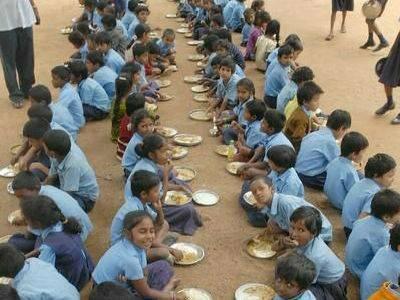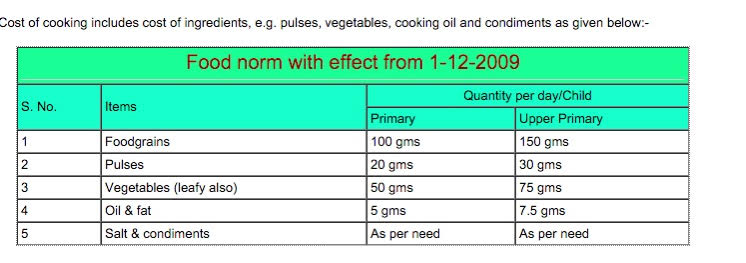There has always been an impression that feeding a child at school – or in an Anganwadi under Integrated Child Development Services (ICDS) for that matter - is a welfare measure and hence is subject to the discretionary powers of the State.
A study of our Constitution however shows that under Article 47, ‘The State shall regard the raising of the level of nutrition and the standard of living of its people and the improvement of public health as among its primary duties’. The Supreme Court through its various directives on the subject has further recognized that it is indeed a derived right for the children.
Though the centre and the state governments are following the pursuant orders in a literal sense, it is time the adequacy of their efforts be looked into and questioned.

The current did day meal scheme. Pic: E S Ramamurthy
Data on malnutrition among children in India as published by International Organizations of repute show us in extremely poor light - 30% of all malnourished children in the world seem to be in our country.
Our own internal assessments in 2015 give the number of underweights at 48%, wasted at 19% and stunted children at 38% respectively.
The government claims that more than 95% of children in the age group of 6-14 years are in school now and hence under the mid-day meal program. Thus this program emerges as a powerful platform for addressing the issue, provided it is designed and implemented properly.
In the context of adequacy of the intervention, two factors needed to be looked at.
First comes the design. For nearly a decade we have been working with two sets of numbers to define the scope of the program: the number of calories to be supplied through the meal and the components of the meal in terms of the nutrients. Regarding the former, the present rules stipulate that the child at the lower primary stage should get 450 calories and at the higher primary 750 calories. There is no comprehensive study carried out under Indian conditions to justify these numbers, though it is an obligatory function of the State.
In fact limited studies done by ‘non-official’ organizations place the total requirement so high that these limits do not seem to be warranted; further one cannot in fairness expect the gap to be filled up by the parents through the remaining meals of the day, given their economic status. The severity of this problem can be understood only when one recognizes that a large proportion of the kids do not even get a breakfast at home in anticipation of the hot meal provided at the school. In the light of the above, it is no surprise when the children end up malnourished, even where the delivery conditions for the meal are ideal.
Second is the nutrient quotients in the meal and the feasibility of realizing them within the allocated funding. Based on the actual expenses incurred and the number of children covered, one finds that the total expense of the MDM program per child per day works out to Rs 7.66; the allocable expense to the meal out of this calculated on the basis of the previous year budget is Rs 5.67. The meal is to contain 100 gms of grain, 20 gms of pulses, 50 gms of vegetables and 5 gms of oil besides salt, condiments etc.

Calculation of calories 450/750 and current costs on the basis of the flgure. Pic: http://mdm.nic.in/
On current costs, the first four items alone will need roughly Rs 11, even when the grains are released from FCI on subsidized rates. Under the circumstances one can easily see the extent of ‘dilution’ of the dietary norms the school has to resort to, in order to stay within the allocations made to them. The scenario gets worse when one takes into account the problems arising from irregular cash flow due to delayed release of funds – a regular occurrence- and an unimaginative control regime.

On the conceptual level, this scheme should not be viewed in the limited context of achieving better attendance in schools; it is well known that inadequate nutrition tends to affect the acquisition of cognitive skills as well, resulting in unacceptable learning levels on the part of the child.
It is time the center and state governments are persuaded to take a fresh look at the entire scheme in consultation with one of its own specialist organizations like National Institute of Nutrition and enhance the financial outlay in line with its recommendations to meet the goal of eradicating malnourishment.
Considering that even a doubling of the allocation will involve no more than Rs 15,000 Crores, a miniscule amount whichever one looks at it, the hurdle here is certainly not availability of funds; it is one of the will required to address this national malady.
References
http://mdm.nic.in/Files/Right%20to%20information/Info_under_RTI%20ACT_MDM_Division_3dec_12.pdf























